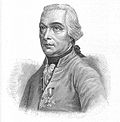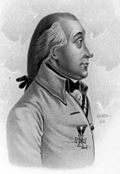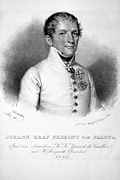Battle of Marengo order of battle

The Battle of Marengo (14 June 1800) was fought between the French army of First Consul Napoleon Bonaparte and an Habsburg army led by General der Kavallerie Michael von Melas. With Napoleon's army lying across the Habsburg army's line of communications to the west, Melas resolved to attack. Early in the morning, the Habsburg army advanced from the city of Alessandria and took the French army by surprise. It was not until 9:00 am before Melas' army completely moved through a bottleneck at the Bormida River bridges. At first the Austrian attack stalled, slowed by bitter French resistance. By 3:00 pm, the Habsburg army compelled their outnumbered opponents to retreat.[1] Sore from having two horses killed under him, Melas handed over command of the pursuit to a subordinate and went to the rear.[2] Later in the afternoon, a newly-arrived French division suddenly attacked the pursuing Austrians. Combined with a quick burst of cannon fire and a well-timed cavalry charge, the surprise assault caused a complete collapse of the Austrian center column, which fled to the temporary safety of Alessandria.[3] The French suffered at least 7,700 casualties, including two generals killed and five wounded. The Austrians admitted losing 9,416 killed, wounded and missing, but some estimates range as high as 11,000–12,000 casualties. The Austrians lost one general killed and five wounded.[4] The next day, Melas requested an armistice. The victory gave Bonaparte enough bargaining leverage to gain control of northwest Italy during the subsequent negotiations.[3]
French Army
[edit]General Staff
[edit]- First Consul Napoleon Bonaparte[5]
- Commander-in-Chief: General of Division Louis-Alexandre Berthier (acted as Chief of Staff and Reserve Commander)
- Chief of Staff: General of Division Pierre Dupont de l'Étang
- Chief Engineer: General of Division Armand Samuel de Marescot
- Chief of Artillery: General of Brigade Auguste de Marmont
-
Napoleon Bonaparte
-
Louis-Alexandre Berthier
-
Pierre Dupont de l'Étang
-
Armand de Marescot
-
Auguste de Marmont
Corps Commanders
[edit]-
Jean Lannes
-
Claude Victor-Perrin
-
Louis Desaix
-
Joachim Murat
Organization
[edit]| Corps | Division | Strength | Brigades[6][note 1] | Units | Strength |
|---|---|---|---|---|---|
| Corps Lannes General of Division Jean Lannes |
Advance Guard | 1,577 | General of Brigade Joseph Mainoni (WIA) |
28th Line Infantry Demi-brigade, 3 battalions | 1,577 |
| Division Watrin General of Division François Watrin |
5,071 | General of Brigade Jean-Pierre Firmin Malher (WIA) |
6th Light Infantry Demi-brigade, 3 battalions | 1,408 | |
| 40th Line Infantry Demi-brigade, 3 battalions | 2,136 | ||||
| General of Brigade Claude Ursule Gency |
22nd Line Infantry Demi-brigade, 3 battalions | 1,527 | |||
| Artillery | – | None | 2nd Horse Artillery Regiment, 2nd Company | 6 guns, caliber? | |
| Cavalry | 214 | None | 5th Dragoon Regiment | 214[note 2] | |
| Corps Victor General of Division Claude Perrin Victor |
Division Gardanne General of Division Gaspard Amédée Gardanne |
3,178 | None | 44th Line Infantry Demi-brigade, 3 battalions | 2,248 |
| 101st Line Infantry Demi-brigade, 3 battalions | 930 | ||||
| Unknown | 2 3-pound cannons | ||||
| Division Chambarlhac General of Division Jacques-Antoine Chambarlhac |
6,564 | General of Brigade Jean-Baptiste Herbin Dessaux |
24th Light Infantry Demi-brigade, 3 battalions | 2,171 | |
| 43rd Line Infantry Demi-brigade, 3 battalions | 2,326 | ||||
| General of Brigade Olivier Macoux Rivaud (WIA) |
96th Line Infantry Demi-brigade, 3 battalions | 2,067 | |||
| Artillery | 5th Horse Artillery Regiment, 4th Company | 1 4-pound cannon 4 guns, caliber? | |||
| Cavalry | 262 | None | 3rd Cavalry Regiment, 2 squadrons | 262 | |
| Corps Desaix General of Division Louis Desaix † |
Division Boudet General of Division Jean Boudet (WIA) |
4,856 | General of Brigade Louis François Félix Musnier |
9th Light Infantry Demi-brigade, 3 battalions | 1,833 |
| 30th Line Infantry Demi-brigade, 3 battalions | 1,200 | ||||
| General of Brigade Louis Charles de Guénand (WIA) |
59th Line Infantry Demi-brigade, 3 battalions | 1,823 | |||
| Artillery | 2nd Horse Artillery Regiment, 3rd Company | 4 4-pounder cannons | |||
| 2nd Horse Artillery Regiment, 4th Company | 4 8-pound cannons | ||||
| Division Monnier General of Division Jean-Charles Monnier |
3,983 | General of Brigade Claude Carra Saint-Cyr |
19th Light Infantry Demi-brigade, 2 battalions | 673 | |
| 70th Line Infantry Demi-brigade, 3 battalions | 1,410 | ||||
| General of Brigade Jean Jacques Schilt |
72nd Line Infantry Demi-brigade, 3 battalions | 1,900 | |||
| Artillery | 1st Foot Artillery Regiment, 5th Company | 1 8-pound cannon 1 howitzer, 110 men | |||
| 6th Foot Artillery Regiment, 10th Company | 2 3-pound cannons | ||||
| Cavalry | 120 | None | 1st Hussar Regiment, 1 squadron | 120 | |
| Reserve Cavalry General of Division Joachim Murat |
None | 2,898 | General of Brigade Bernard Étienne Marie Duvignau |
6th Dragoon Regiment, 4 squadrons | 393 |
| 8th Dragoon Regiment, 4 squadrons | 443 | ||||
| 12th Horse Chasseur Regiment, 4 squadrons | 391 | ||||
| General of Brigade François Etienne de Kellermann |
1st Cavalry Regiment | 123 | |||
| 2nd Cavalry Regiment, 1 squadron | 258 | ||||
| 20th Cavalry Regiment, 3 squadrons | 191 | ||||
| General of Brigade Pierre Champeaux † |
9th Dragoon Regiment, 3 squadrons | 150 | |||
| 15th Horse Chasseur Regiment | 249 | ||||
| General of Brigade Jean Rivaud (Not engaged) |
12th Hussar Regiment, 4 squadrons | 340 | |||
| 21st Horse Chasseur Regiment, 4 squadrons | 360 | ||||
| Reserve General of Division Louis-Alexandre Berthier |
Consular Guard | 1,232 | Colonel Jérôme Soulès |
Foot Grenadier Regiment | c. 400 |
| Foot Chasseur Regiment | c. 400 | ||||
| Colonel Jean-Baptiste Bessières |
Guard Horse Grenadiers | c. 240 | |||
| Guard Horse Chasseurs | c. 120 | ||||
| Artillery | Guard Artillery Company | 2 8-pound cannons 1 howitzer, 72 men | |||
| Reserve Artillery General of Brigade Auguste de Marmont |
421 | None | Unknown | 2 6-pound cannons 3 guns, caliber? | |
| Military Engineers General of Division Armand Samuel de Marescot |
269 | None | Sappers | 269 | |
| Grand Total | – | 29,942 | – | – | 29,942, 33 guns |
Habsburg Army
[edit]General Staff
[edit]- Commander-in-chief: General der Kavallerie Michael von Melas[7]
- Chief of Staff: General-major Anton von Zach (POW)[8]
Habsburg commanders
[edit]-
Michael von Melas
-
Anton von Zach
-
Karl Joseph Hadik
-
Peter Karl Ott
-
Johann Philipp Frimont
Organization
[edit]| Wing | Division | Strength | Brigades | Units | Strength |
|---|---|---|---|---|---|
| Advance Guard | None | 1,290 | Oberst (Colonel) Johann Maria Philipp Frimont |
Mariassy Jäger Battalion, 4 companies | 164 |
| Am Ende Light Battalion Nr. 3 | 291 | ||||
| Bach Light Battalion Nr. 4 | 277 | ||||
| Pioneers, 1 company | 100 | ||||
| Kaiser Dragoon Regiment Nr. 1, 2 squadrons | 272 | ||||
| Bussy Horse Jäger (French Émigré) Regiment, 2 squadrons | 186 | ||||
| Cavalry Battery | – | ||||
| Right Wing | Feldmarschall-Leutnant Andreas O'Reilly von Ballinlough |
2,997 | General-major Franz Rousseau d'Heriamont |
Mariassy Jäger Battalion, 1 company | 40 |
| Ottocaner Grenz Infantry Regiment Nr. 2, 1 battalion | 298 | ||||
| Oguliner Grenz Infantry Regiment Nr. 3, 1 battalion | 602 | ||||
| Banater Grenz Infantry Regiment Nr. 4, 1 battalion | 533 | ||||
| Warasdiner-Kreutzer Grenz Infantry Regiment Nr. 5, 1 battalion | 755 | ||||
| Nauendorf Hussar Regiment Nr. 8, 3⅓ squadrons | 426 | ||||
| Hussar Regiment Nr. 5, 2 squadrons | 230 | ||||
| Württemberg Dragoon Regiment Nr. 8, 1 squadron | 113 | ||||
| Cavalry battery | – | ||||
| Center General der Kavallerie Michael von Melas |
Feldmarschall-Leutnant Karl Joseph Hadik von Futak † |
5,039 | General-major Franz (Giovanni) Pilati von Tassulo |
Kaiser Dragoon Regiment Nr. 1, 3 squadrons | 309 |
| Karaczay Dragoon Regiment Nr. 4, 6 squadrons | 1,053 | ||||
| General-major Friedrich Joseph Anton von Bellegarde (WIA) |
Archduke Anton Infantry Regiment Nr. 52, 2 battalions | 855 | |||
| Johann Jellacic Infantry Regiment Nr. 53, 1 battalion | 613 | ||||
| General-major Franz Xaver Saint-Julien |
Michael Wallis Infantry Regiment Nr. 11, 3 battalions | 2,209 | |||
| Feldmarschall-Leutnant Konrad Valentin von Kaim |
4,939 | General-major Auguste-François Landres de Briey |
Franz Kinsky Infantry Regiment Nr. 47, 2⅓ battalions | 1,640 | |
| General-major Vinko Knežević (Vinzenz Knesevich) |
Tuscany Infantry Regiment Nr. 23, 3 battalions | 2,188 | |||
| General-major Ludwig Wolff de la Marselle (WIA) |
Archduke Josef Infantry Regiment Nr. 63, 3 battalions | 1,111 | |||
| Feldmarschall-Leutnant Anton von Elsnitz |
4,214 | General-major Johann Baptist Nobili von Loptay |
Archduke Johann Dragoon Regiment Nr. 3, 6 squadrons | 859 | |
| Liechtenstein Dragoon Regiment Nr. 9, 6 squadrons | 1,014 | ||||
| General-major Joseph Nimptsch von Fürst und Kupferberg (Not engaged) |
Hussar Regiment Nr. 7, 8 squadrons | 1,353 | |||
| Erdödy Hussar Regiment Nr. 9, 6 squadrons | 988 | ||||
| Feldmarschall-Leutnant Ferdinand Johann von Morzin[6][note 3] |
4,756 | General-major Christoph von Lattermann (WIA) |
Paar Grenadier battalion | 2,116[note 4] | |
| Pers Grenadier battalion | – | ||||
| Sciaffinati Grenadier battalion | – | ||||
| Weber Grenadier battalion | – | ||||
| Czerwenka Grenadier battalion | – | ||||
| General-major Karl Philippi von Weidenfeld |
Pertusy Grenadier battalion | 2,240[note 5] | |||
| Piret Grenadier battalion | – | ||||
| Khevenhüller Grenadier battalion | – | ||||
| Gorschen Grenadier battalion | – | ||||
| Weissenwolf Grenadier battalion | – | ||||
| Saint-Julien Grenadier battalion | – | ||||
| Attached Pioneers | Pioneers, 4 companies | 400 | |||
| Left Wing Feldmarschall-Leutnant Peter Karl Ott von Bátorkéz |
Advance Guard | 811 | General-major Friedrich Heinrich von Gottesheim (WIA) |
Mariassy Jäger Battalion, 1 company | 40 |
| Frölich Infantry Regiment Nr. 28, 1 battalion | 523 | ||||
| Lobkowitz Dragoon Regiment Nr. 10, 2 squadrons | 248 | ||||
| Feldmarschall-Leutnant Ludwig von Vogelsang (WIA) |
2,194 | General-major Josef Kajetan von Ulm zu Erbach |
Hohenlohe Infantry Regiment Nr. 17, 2 battalions | 912 | |
| Stuart Infantry Regiment Nr. 18, 3 battalions | 1,282 | ||||
| Feldmarschall-Leutnant Joseph von Schellenberg |
4,597 | General-major Anton von Retz |
Pioneers, 1 company | 100 | |
| Frölich Infantry Regiment Nr. 28, 2 battalions | 1,046 | ||||
| Joseph Mittrowsky Infantry Regiment Nr. 40, 3 battalions | 853 | ||||
| General-major Franz Seraph Sticker von Haymingthal |
Splenyi Infantry Regiment Nr. 51, 2 battalions | 737 | |||
| Josef Colloredo Infantry Regiment Nr. 57, 3 battalions) | 1,369 | ||||
| Lobkowitz Dragoon Regiment Nr. 10, 4 squadrons) | 492 | ||||
| Grand Total | – | 30,379 | – | – | 30,379 92 guns[note 6] |
Notes
[edit]- Footnotes
- ^ Smith provided the French brigade organizations, the fact that the 19th Light had only 2 battalions, and the number of squadrons per regiment.
- ^ One squadron of 72 troopers was detached to army headquarters.
- ^ Arnold did not list the grenadier battalions, other than to show Lattermann had five and Weidenfeld had six. Smith listed the battalions without noting which brigade they belonged to. However, the way they were ordered suggested that the lists in this table are probably accurate.
- ^ This is the total strength of Lattermann's brigade.
- ^ This is the total strength of Weidenfeld's brigade.
- ^ Battalion guns are not counted in the total.
- Citations
- ^ Chandler 1966, pp. 290–293.
- ^ Arnold 2005, p. 171.
- ^ a b Chandler 1966, pp. 293–296.
- ^ Arnold 2005, pp. 190–191.
- ^ a b Arnold 2005, pp. 270–271.
- ^ a b Smith 1998, pp. 186–187.
- ^ a b Arnold 2005, pp. 272–273.
- ^ Arnold 2005, p. 60.
References
[edit]- Arnold, James R. (2005). Marengo & Hohenlinden: Napoleon's Rise to Power. Barnsley, South Yorkshire: Pen and Sword. ISBN 1-84415-279-0.
- Chandler, David G. (1966). The Campaigns of Napoleon. New York, N.Y.: Macmillan.
- Smith, Digby (1998). The Napoleonic Wars Data Book. London: Greenhill. ISBN 1-85367-276-9.
External links
[edit]- Broughton, Tony (2010). "Generals Who Served in the French Army during the Period 1789–1815". napoleon-series.org. Retrieved 24 April 2018. This is the source of the full names of French generals.
- Smith, Digby; Kudrna, Leopold (2008). "Austrian Generals during the French Revolutionary and Napoleonic Wars 1792–1815". napoleon-series.org. Retrieved 14 April 2018. This is the source of the full names of Habsburg Austrian generals.















